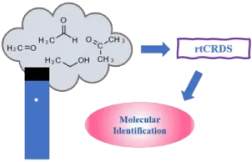News

Seafloor hydrothermalism plays a critical role in fundamental interactions between geochemical and biological processes in the deep ocean. A significant number of hydrothermal vents are hypothesized to exist, but many of these remain undiscovered due in part to the difficulty of detecting hydrothermalism using standard sensors on rosettes towed in the water column or robotic platforms performing surveys. Here, we use in situ methane sensors to complement standard sensing technology for hydrothermalism discovery and compare sensors on a towed rosette and an autonomous underwater vehicle (AUV) during a 17 km long transect in the Northern Guaymas Basin in the Gulf of California. This transect spatially intersected with a known hydrothermally active venting site. These data show that methane signalled possible hydrothermal-activity 1.5–3 km laterally (100–150 m vertically) from a known vent. Methane as a signal for hydrothermalism performed similarly to standard turbidity sensors (plume detection 2.2–3.3 km from reference source), and more sensitively and clearly than temperature, salinity, and oxygen instruments which readily respond to physical mixing in background seawater. We additionally introduce change-point detection algorithms—streaming cross-correlation and regime identification—as a means of real-time hydrothermalism discovery and discuss related data supervision technologies that could be used in planning, executing, and monitoring explorative surveys for hydrothermalism.

New facilities at the Berrimah Farm Science Precinct offer innovative opportunities to enhance biosecurity surveillance, diagnostics, preparedness and response across northern Australia.
The Australian Government is working closely with the NT government and Top End stakeholders on innovative ways to reduce the impact of costs of managing biosecurity risks.
The new facilities at the Berrimah Farm Science Precinct offer innovative opportunities to enhance biosecurity surveillance, diagnostics, preparedness and response across northern Australia, while offering scope to leverage further investment to support innovative research and development to support the expansion of northern industries.
Minister for Agriculture and Northern Australia David Littleproud said the Berrimah Farm had implemented numerous innovative approaches and technologies to stay ahead of biosecurity risks and reduce costs to industry of incursions by exotic pests and diseases.
“Innovation is critical for Top End biosecurity, that is why we have invested $3.5 million in this facility,” Minister Littleproud said.
“Northern Australia is a high-risk zone for an incursion of exotic pests and diseases such as exotic fruit fly and African swine fever, because of its proximity to countries to our north and the existence of natural biosecurity risk pathways.
“The Australian Government is working closely with the NT government and Top End stakeholders on innovative ways to reduce the impact of costs of managing biosecurity risks.
“This includes through enhancing and expanding how and where detector dogs can be used. Recent trials have shown detector dogs successfully picking up the scent of Citrus Canker and Siam Weed.

A mobile device built by Albuquerque startup RingIR Inc. could soon provide mass screening capability for coronavirus at highly congested settings like airports, with results in seconds.
The National Institutes of Health already financed initial testing on people at the University of New Mexico Hospital and at Emory University in Georgia with promising results. And follow-on funding through NIH’s Rapid Acceleration of Diagnostics, or RADx, initiative is in the works to expand testing to more institutions across the country, said RingIR founder, President and CEO Charles Harb.
“The UNMH trial showed we had something potentially groundbreaking,” Harb told the Journal. “So RADx decided to extend its involvement.”
Read the entire story at the Albuquerque Journal Website

Growing demand of Juul and other electronic cigarettes, despite critical knowledge gaps about their chemical composition, has led to concerns regarding their potential health effects. We introduce a novel analytical approach, runtime cavity ringdown spectroscopy (rtCRDS) for rapid detection of oxidative products in e-cigarette aerosols, to facilitate the study of aerosol from a single puff of e-liquid. We report a systematic investigation of three flavors of commercial Juul pods (Virginia tobacco, mango, and menthol) and known commercial e-liquid ingredients (propylene glycol (PG), vegetable glycerin (VG), nicotine, ethyl maltol, benzoic acid, and nicotine benzoate) vaped using Juul devices. Juul e-liquids and neat chemical additives spiked into a 30:70 PG/VG solution were vaped and their aerosols were collected in 1-L Tedlar gas bags and analyzed using rtCRDS. Acetaldehyde, formaldehyde, and acetone were identified as primary oxidative products in aerosolized PG/VG. Ethanol was detected as a major constituent of the three commercial Juul flavors. Spectral intensities of carbonyl compounds increased with the addition of spikes, benzoic acid, ethyl maltol, and nicotine to PG/VG, suggesting that oxidative product generation increases with common additives. The method of direct, rapid analysis of e-cig aerosols introduced here can be used to complement traditional methods in vaping exposures.

An Albuquerque company is developing technology that could revolutionize COVID-19 testing. Instead of waiting days or hours for your results, you could know within seconds. The testing would be done without a swab in your mouth or up your nose.

Minister for Defence Industry, the Hon Christopher Pyne MP, today announced New South Wales-based company RingIR Pty Ltd, would receive $4.6 million to develop and demonstrate an innovative technology to enhance Defence capability.
Minister Pyne said he through the Defence Innovation Hub funding RingIR would develop a counter-improvised explosive device (IED) capability, which uses highly sensitive laser spectrometry technique to locate and identify the vapours exuded from explosives.
“This technology could be used to determine the location and type of IED, allowing Australian Defence Force (ADF) personnel to effectively respond to improvised threats,” Minister Pyne said.

An Albuquerque startup is emerging from stealth mode this week to commercialize new, mobile technology that can immediately detect and identify gasses for security, industrial or research purposes.
The company, RingIR Inc., launched in Albuquerque in August 2016 at the WESST incubator Downtown after more than 10 years developing its technology in Australia and New Mexico. But it remained under the radar until now to advance its initial technology prototypes and begin building business operations before going public.
Read more at the Albuquerque Journal website.

I am text block. Click edit button to change this text. Lorem ipsum dolor sit amet, consectetur adipiscing elit. Ut elit tellus, luctus nec ullamcorper mattis, pulvinar dapibus leo.

Optical cavity enhancement is a highly desirable process to make sensitive direct-absorption spectroscopic measurements of unknown substances, such as explosives, illicit material, or other species of interest. This paper reports advancements in the development of real-time cavity ringdown spectroscopy over a wide-bandwidth, with the aim to make headspace measurements of molecules at trace levels. We report results of two pulsed quantum cascade systems operating between (1200 to 1320)cm−1 and (1316 to 1613)cm−1 that measure the headspace of nitromethane, acetonitrile, acetone, and nitroglycerin, where the spectra are obtained in less than four seconds and contain at least 150,000 spectral wavelength datapoints.

This paper presents results from a pulsed-laser cavity ring-down spectrometer with novel field programable gate array real-time data collection. We show both theoretically and experimentally that the data extraction can be achieved from a single cavity ringdown event, and that the absorbance can be determined without the need to fit the ringdown time explicitly. This methodology could potentially provide data acquisition rate up to 1MHz, with the accuracy and precision comparable to nonlinear least squares fitting algorithms.



